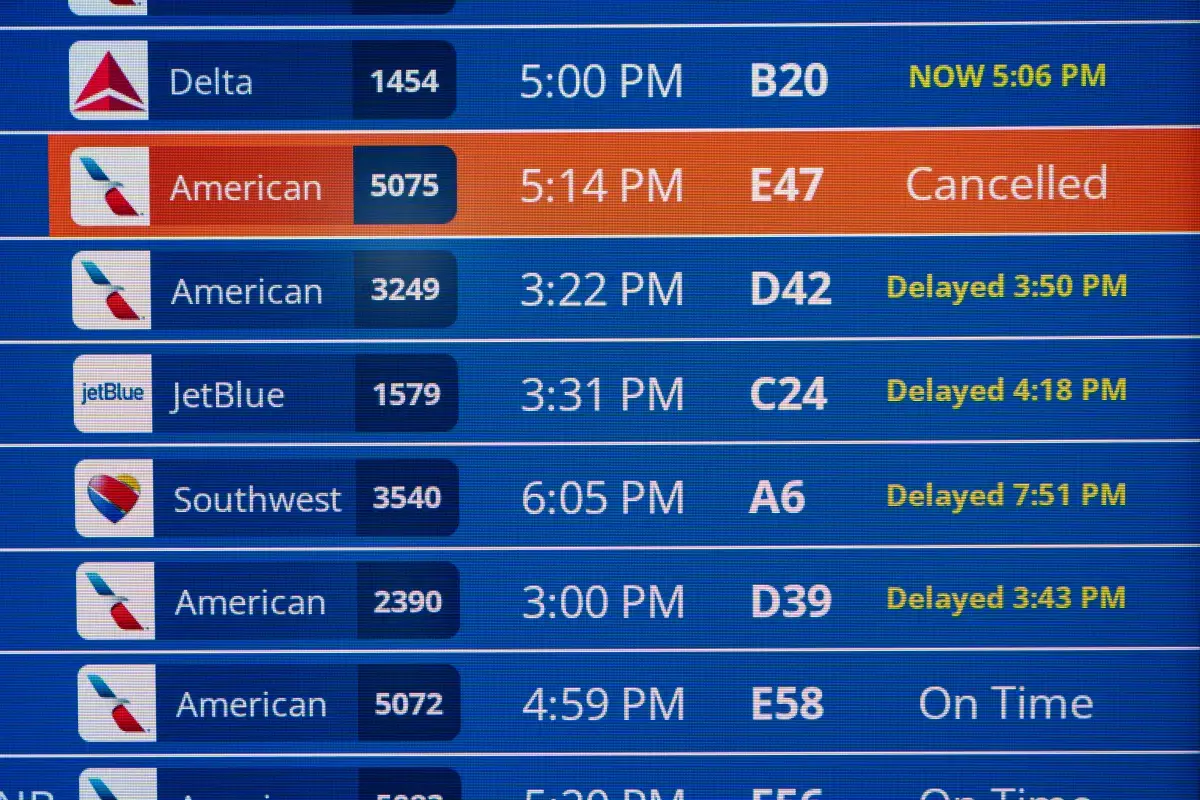Copyright Newsweek

Hundreds of flights across the United States are delayed or canceled today as the ongoing federal government shutdown continues to strain air travel operations. FlightAware data shows that more than 8,100 flights are delayed globally, including 845 within, into, or out of the U.S., while 949 flights are canceled overall—755 of them affecting U.S. routes. Why It Matters The growing chaos at airports is raising alarm ahead of Thanksgiving, when tens of millions of travelers are expected to take to the skies for one of the busiest travel periods of the year. What To Know SkyWest, Southwest, and Envoy Air recorded the highest number of cancellations, while United, Delta, and American Airlines also faced significant delays, according to FlightAware. SkyWest Airlines leads all carriers with 180 cancellations, representing 7 percent of its schedule. Southwest Airlines follows with 102 cancellations and 395 delays, affecting roughly 12 percent of its flights. Envoy Air has cancelled 69 flights, while 2 are delayed. Other major U.S. airlines were also hit: United Airlines reported 62 cancellations, Delta Air Lines has 39, and American Airlines logged 7. At the airport level, Chicago O’Hare International Airport (ORD) tops the list for total disruptions, with over 80 combined cancellations across departures and arrivals. Atlanta’s Hartsfield-Jackson, Denver International, and Dallas–Fort Worth International each have around 60 cancellations between inbound and outbound flights. Orlando International Airport (MCO) recorded one of the highest delay rates, with 78 inbound delays, while Newark Liberty (EWR) and Tampa International (TPA) also report above-average disruptions. Internationally, Asia is seeing extensive ripple effects: Jakarta Soekarno-Hatta (CGK) has over 140 delayed flights, while Shanghai Pudong (PVG) and Beijing Capital (PEK) have each logged more than 100 delays. Other major international hubs like Dubai (DXB), Charles de Gaulle (CDG), and Tokyo Haneda (HND) also report significant slowdowns. The disruption comes as the ongoing government shutdown became the longest one in history this week, as it passed the 36-day mark on Wednesday. The shutdown has caused severe disruption to essential services across the country, and that includes airports. The Federal Aviation Administration (FAA) ordered airlines to cut back on air traffic and travel in 40 airports nationwide. The FAA’s cutbacks started Friday with a 4 percent reduction in flights and are set to expand to 10 percent by November 14. The restrictions apply daily from 6 a.m. to 10 p.m. local time and affect every major commercial carrier. American Airlines and Alaska Airlines are both scaling back flight operations in response to FAA-mandated schedule reductions. American said it has been ordered to cut flight schedules by 4 percent at 40 U.S. airports through Monday, resulting in roughly 220 daily cancellations, though it still expects to operate about 6,000 flights each day. The airline issued a travel waiver allowing passengers to change or cancel without penalty and called the situation “unacceptable,” urging Washington leaders to end the shutdown. Alaska Airlines confirmed similar directives, saying it will cancel 36–40 flights per day through Sunday, while continuing to operate over 1,500 daily flights. The airline said 100 percent of affected passengers have been rebooked and pledged to protect service to smaller and remote communities. Meanwhile, flights were grounded at two major U.S. airports Saturday, with a staffing-related halt at Charlotte Douglas International Airport and a weather-related ground stop at New York’s JFK Airport due to thunderstorms, according to updates posted on X by Air Traffic Control. On Friday, lawmakers rejected another proposal to bring the shutdown to an end. What People Are Saying U.S. Transportation Secretary Sean P. Duffy said in a statement on Thursday: “My department has many responsibilities, but our number one job is safety. This isn’t about politics—it’s about assessing the data and alleviating building risk in the system as controllers continue to work without pay. It’s safe to fly today, and it will continue to be safe to fly next week because of the proactive actions we are taking.” Federal Aviation Administrator Bryan Bedford said in a statement on Thursday: “We are seeing signs of stress in the system, so we are proactively reducing the number of flights to make sure the American people continue to fly safely. The FAA will continue to closely monitor operations, and we will not hesitate to take further action to make sure air travel remains safe.” What Happens Next Additional cancellations are likely in the coming days, and passengers are being urged to monitor airline websites for updates on affected flights, refund options, and other travel guidance.



